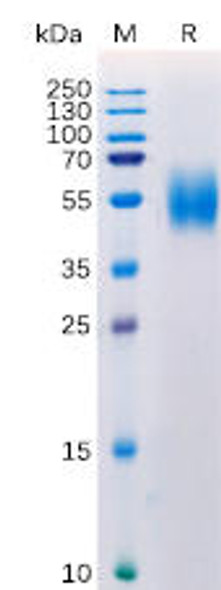Human MICA Recombinant Protein (RPPB3971)
- SKU:
- RPPB3971
- Product Type:
- Recombinant Protein
- Species:
- Human
- Uniprot:
- Q29983
Description
| Product Name: | Human MICA Recombinant Protein |
| Product Code: | RPPB3971 |
| Size: | 10µg |
| Species: | Human |
| Target: | MICA |
| Synonyms: | MHC class I polypeptide-related sequence A, MIC-A, MICA, PERB11.1, HLA-B, AS, HLAB, HLAC, SPDA1, HLA-B73, HLA-B-7301. |
| Source: | Escherichia Coli |
| Physical Appearance: | Sterile Filtered White lyophilized (freeze-dried) powder. |
| Formulation: | Lyophilized from a concentrated (1mg/ml) solution containing no additives. |
| Solubility: | It is recommended to reconstitute the lyophilized MICA in sterile 18M?-cm H2O not less than 100�g/ml, which can then be further diluted to other aqueous solutions. |
| Stability: | Lyophilized MICA although stable at room temperature for 3 weeks, should be stored desiccated below -18°C. Upon reconstitution MICA should be stored at 4°C between 2-7 days and for future use below -18°C.For long term storage it is recommended to add a carrier protein (0.1% HSA or BSA).Please prevent freeze-thaw cycles. |
| Purity: | Greater than 95.0% as determined by:(a) Analysis by RP-HPLC.(b) Analysis by SDS-PAGE. |
| Amino Acid Sequence: | EPHSLRYNLTVLSWDGSVQSGFLAEVHLDGQPFLRYDRQKCRAKPQGQWAEDVLGNKTWDRETRDLTGNGKDLRMTLAHIKDQKEGLHSLQEIRVCEIHEDNSTRSSQHFYYDGELFLSQNLETEEWTVPQSSRAQTLAMNVRNFLKEDAMKTKTHYHAMHADCLQELRRYLESGVVLRRTVPPMVNVTRSEASEGNITVTCRASSFYPRNIILTWRQDGVSLSHDTQQWGDVLPDGNGTYQTWVATRICRGEEQRFTCYMEHSGNHSTHPVPSGKVLVLQSH |
| Biological Activity: | Measured by its ability to bind MICA antibody in ELISA. |
MICA (MHC class I chain-related gene A) is a transmembrane glycoprotein that functions as a ligand for human NKG2D. A closely related protein, MICB, shares 85% amino acid identity with MICA. These proteins are distantly related to the MHC class I proteins. They possess three extracellular Ig-like domains, but they have no capacity to bind peptide or interact with B2-microglobulin. The genes encoding these proteins are found within the Major Histocompatibility Complex on human chromosome 6. The MICA locus is highly polymorphic with more than 50 recognized human alleles. MICA is absent from most cells but is frequently expressed in epithelial tumors and can be induced by bacterial and viral infections. MICA is a ligand for human NKG2D, an activating receptor expressed on NK cells, NKT cells,�gamma�delta T cells, and CD8+�beta T cells. Recognition of MICA by NKG2D results in the activation of cytolytic activity and/or cytokine production by these effector cells. MICA recognition is involved in tumor surveillance, viral infections, and autoimmune diseases.
MICA Human Recombinant produced in E.Coli is a single, non-glycosylated polypeptide chain containing 320 amino acids and having a molecular mass of 36kDa. The sequence contains the full length extracellular domain of the mature human MICA (amino acid residues Ala23 � Gln308) The MICA is purified by proprietary chromatographic techniques.
| UniProt Protein Function: | MICA: Seems to have no role in antigen presentation. Acts as a stress-induced self-antigen that is recognized by gamma delta T- cells. Ligand for the KLRK1/NKG2D receptor. Binding to KLRK1 leads to cell lysis. Anti-MICA antibodies and ligand shedding are involved in the progression of monoclonal gammopathy of undetermined significance (MGUS)to multiple myeloma. Genetic variations in MICA may be a cause of susceptibility to psoriasis type 1 (PSORS1). Psoriasis is a common, chronic inflammatory disease of the skin with multifactorial etiology. It is characterized by red, scaly plaques usually found on the scalp, elbows and knees. These lesions are caused by abnormal keratinocyte proliferation and infiltration of inflammatory cells into the dermis and epidermis. Genetic variation in MICA is a cause of susceptibility to psoriatic arthritis (PSORAS). PSORAS is an inflammatory, seronegative arthritis associated with psoriasis. It is a heterogeneous disorder ranging from a mild, non-destructive disease to a severe, progressive, erosive arthropathy. Five types of psoriatic arthritis have been defined: asymmetrical oligoarthritis characterized by primary involvement of the small joints of the fingers or toes; asymmetrical arthritis which involves the joints of the extremities; symmetrical polyarthritis characterized by a rheumatoidlike pattern that can involve hands, wrists, ankles, and feet; arthritis mutilans, which is a rare but deforming and destructive condition; arthritis of the sacroiliac joints and spine (psoriatic spondylitis). Belongs to the MHC class I family. MIC subfamily. 2 isoforms of the human protein are produced by alternative splicing. |
| UniProt Protein Details: | Protein type:Membrane protein, integral Chromosomal Location of Human Ortholog: 6p21.33 Cellular Component: extracellular space; cell surface; integral to plasma membrane; cytoplasm Molecular Function:protein binding; beta-2-microglobulin binding; antigen binding; natural killer cell lectin-like receptor binding Biological Process: antigen processing and presentation; viral reproduction; natural killer cell mediated cytotoxicity; response to heat; cytolysis; defense response to bacterium; immune response to tumor cell; gamma-delta T cell activation; response to DNA damage stimulus; defense response to virus; T cell mediated cytotoxicity Disease: Psoriatic Arthritis, Susceptibility To; Psoriasis 1, Susceptibility To |
| NCBI Summary: | This gene encodes the highly polymorphic major histocompatability complex class I chain-related protein A. The protein product is expressed on the cell surface, although unlike canonical class I molecules it does not seem to associate with beta-2-microglobulin. It is a ligand for the NKG2-D type II integral membrane protein receptor. The protein functions as a stress-induced antigen that is broadly recognized by intestinal epithelial gamma delta T cells. Variations in this gene have been associated with susceptibility to psoriasis 1 and psoriatic arthritis, and the shedding of MICA-related antibodies and ligands is involved in the progression from monoclonal gammopathy of undetermined significance to multiple myeloma. Alternative splicing of this gene results in multiple transcript variants. [provided by RefSeq, Jan 2014] |
| UniProt Code: | Q29983 |
| NCBI GenInfo Identifier: | 74740024 |
| NCBI Gene ID: | 100507436 |
| NCBI Accession: | Q29983.1 |
| UniProt Related Accession: | Q29983 |
| Molecular Weight: | |
| NCBI Full Name: | MHC class I polypeptide-related sequence A |
| NCBI Synonym Full Names: | MHC class I polypeptide-related sequence A |
| NCBI Official Symbol: | MICA�� |
| NCBI Official Synonym Symbols: | MIC-A; PERB11.1�� |
| NCBI Protein Information: | MHC class I polypeptide-related sequence A |
| UniProt Protein Name: | MHC class I polypeptide-related sequence A |
| Protein Family: | MICAL-like protein |
| UniProt Gene Name: | MICA�� |
| UniProt Entry Name: | MICA_HUMAN |










